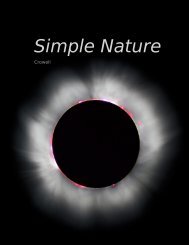The size of a radio antenna is closely related to ... - Light and Matter
The size of a radio antenna is closely related to ... - Light and Matter
The size of a radio antenna is closely related to ... - Light and Matter
You also want an ePaper? Increase the reach of your titles
YUMPU automatically turns print PDFs into web optimized ePapers that Google loves.
f / <strong>The</strong> correspondence principle<br />
requires that the relativ<strong>is</strong>tic<br />
d<strong>is</strong><strong>to</strong>rtion <strong>of</strong> time become small<br />
for small velocities.<br />
until section 7.4, <strong>and</strong> that means that what we want <strong>to</strong> focus on<br />
right now <strong>is</strong> the d<strong>is</strong><strong>to</strong>rtion <strong>of</strong> time due <strong>to</strong> motion, not gravity.<br />
We can now see in more detail how <strong>to</strong> apply the correspondence<br />
principle. <strong>The</strong> behavior <strong>of</strong> the three clocks in the Hafele-Keating<br />
experiment shows that the amount <strong>of</strong> time d<strong>is</strong><strong>to</strong>rtion increases as<br />
the speed <strong>of</strong> the clock’s motion increases. New<strong>to</strong>n lived in an era<br />
when the fastest mode <strong>of</strong> transportation was a galloping horse, <strong>and</strong><br />
the best pendulum clocks would accumulate errors <strong>of</strong> perhaps a<br />
minute over the course <strong>of</strong> several days. A horse <strong>is</strong> much slower<br />
than a jet plane, so the d<strong>is</strong><strong>to</strong>rtion <strong>of</strong> time would have had a relative<br />
<strong>size</strong> <strong>of</strong> only ∼ 10 −15 — much smaller than the clocks were capable<br />
<strong>of</strong> detecting. At the speed <strong>of</strong> a passenger jet, the effect <strong>is</strong> about<br />
10 −12 , <strong>and</strong> state-<strong>of</strong>-the-art a<strong>to</strong>mic clocks in 1971 were capable <strong>of</strong><br />
measuring that. A GPS satellite travels much faster than a jet airplane,<br />
<strong>and</strong> the effect on the satellite turns out <strong>to</strong> be ∼ 10 −10 . <strong>The</strong><br />
general idea here <strong>is</strong> that all physical laws are approximations, <strong>and</strong><br />
approximations aren’t simply right or wrong in different situations.<br />
Approximations are better or worse in different situations, <strong>and</strong> the<br />
question <strong>is</strong> whether a particular approximation <strong>is</strong> good enough in a<br />
given situation <strong>to</strong> serve a particular purpose. <strong>The</strong> faster the motion,<br />
the worse the New<strong>to</strong>nian approximation <strong>of</strong> absolute time. Whether<br />
the approximation <strong>is</strong> good enough depends on what you’re trying<br />
<strong>to</strong> accompl<strong>is</strong>h. <strong>The</strong> correspondence principle says that the approximation<br />
must have been good enough <strong>to</strong> explain all the experiments<br />
done in the centuries before Einstein came up with relativity.<br />
By the way, don’t get an inflated idea <strong>of</strong> the importance <strong>of</strong> the<br />
Hafele-Keating experiment. Special relativity had already been confirmed<br />
by a vast <strong>and</strong> varied body <strong>of</strong> experiments decades before 1971.<br />
<strong>The</strong> only reason I’m giving such a prominent role <strong>to</strong> th<strong>is</strong> experiment,<br />
which was actually more important as a test <strong>of</strong> general relativity, <strong>is</strong><br />
that it <strong>is</strong> conceptually very direct.<br />
7.2 D<strong>is</strong><strong>to</strong>rtion <strong>of</strong> Space <strong>and</strong> Time<br />
7.2.1 <strong>The</strong> Lorentz transformation<br />
Relativity says that when two observers are in different frames <strong>of</strong><br />
reference, each observer considers the other one’s perception <strong>of</strong> time<br />
<strong>to</strong> be d<strong>is</strong><strong>to</strong>rted. We’ll also see that something similar happens <strong>to</strong><br />
their observations <strong>of</strong> d<strong>is</strong>tances, so both space <strong>and</strong> time are d<strong>is</strong><strong>to</strong>rted.<br />
What exactly <strong>is</strong> th<strong>is</strong> d<strong>is</strong><strong>to</strong>rtion? How do we even conceptualize it?<br />
<strong>The</strong> idea <strong>is</strong>n’t really as radical as it might seem at first. We<br />
can v<strong>is</strong>ualize the structure <strong>of</strong> space <strong>and</strong> time using a graph with<br />
position <strong>and</strong> time on its axes. <strong>The</strong>se graphs are familiar by now,<br />
but we’re going <strong>to</strong> look at them in a slightly different way. Before, we<br />
used them <strong>to</strong> describe the motion <strong>of</strong> objects. <strong>The</strong> grid underlying<br />
the graph was merely the stage on which the ac<strong>to</strong>rs played their<br />
384 Chapter 7 Relativity














